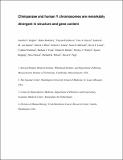Chimpanzee and Human Y Chromosomes Are Remarkably Divergent in Structure and Gene Content
Author(s)
Hughes, Jennifer F.; Skaletsky, Helen; Pyntikova, Tatyana; Graves, Tina; van Daalen, Saskia K. M.; Minx, Patrick J.; Fulton, Robert S.; McGrath, Sean D.; Locke, Devin P.; Friedman, Cynthia; Trask, Barbara J.; Mardis, Elaine R.; Warren, Wesley C.; Repping, Sjoerd; Rozen, Steve; Wilson, Richard K.; Page, David C; ... Show more Show less
Downloadmain article (199.9Kb)
OPEN_ACCESS_POLICY
Open Access Policy
Creative Commons Attribution-Noncommercial-Share Alike
Terms of use
Metadata
Show full item recordAbstract
The human Y chromosome began to evolve from an autosome hundreds of millions of years ago, acquiring a sex-determining function and undergoing a series of inversions that suppressed crossing over with the X chromosome[1, 2]. Little is known about the recent evolution of the Y chromosome because only the human Y chromosome has been fully sequenced. Prevailing theories hold that Y chromosomes evolve by gene loss, the pace of which slows over time, eventually leading to a paucity of genes, and stasis [3, 4]. These theories have been buttressed by partial sequence data from newly emergent plant and animal Y chromosomes [5, 6, 7, 8], but they have not been tested in older, highly evolved Y chromosomes such as that of humans. Here we finished sequencing of the male-specific region of the Y chromosome (MSY) in our closest living relative, the chimpanzee, achieving levels of accuracy and completion previously reached for the human MSY. By comparing the MSYs of the two species we show that they differ radically in sequence structure and gene content, indicating rapid evolution during the past 6 million years. The chimpanzee MSY contains twice as many massive palindromes as the human MSY, yet it has lost large fractions of the MSY protein-coding genes and gene families present in the last common ancestor. We suggest that the extraordinary divergence of the chimpanzee and human MSYs was driven by four synergistic factors: the prominent role of the MSY in sperm production, ‘genetic hitchhiking’ effects in the absence of meiotic crossing over, frequent ectopic recombination within the MSY, and species differences in mating behaviour. Although genetic decay may be the principal dynamic in the evolution of newly emergent Y chromosomes, wholesale renovation is the paramount theme in the continuing evolution of chimpanzee, human and perhaps other older MSYs.
Description
Letter
Date issued
2010-01Department
Massachusetts Institute of Technology. Department of Biology; Whitehead Institute for Biomedical ResearchJournal
Nature
Publisher
Nature Publishing Group
Citation
Hughes, Jennifer F. et al. “Chimpanzee and human Y chromosomes are remarkably divergent in structure and gene content.” Nature 463.7280 (2010): 536-539.
Version: Author's final manuscript
ISSN
0028-0836
1476-4687